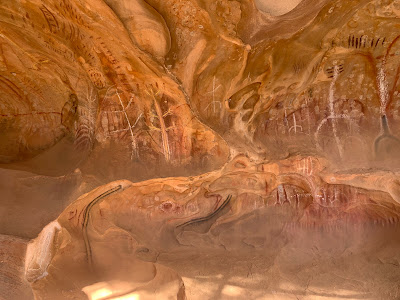Judy. Since we were taking our Transpacific cruise from Brisbane, Queensland, we thought we might as well spend a couple of days there and take in one more bit of Australia. I’m glad we did; it couldn’t be any more different from our days in quiet Adelaide.
Brisbane is Australia’s third largest city, quickly catching up to Melbourne, if the stories we were told are true. More than once we heard it called “Brisvegas” because of all the casinos, and we sure saw a lot of those!
 |
| New casino going up behind an old government building |
A couple of people described it to me as a combination of a country town and a modern city, and the architecture bears that out. New, shiny modern skyscrapers snuggle up to old territorial government buildings. Our hotel was a 26-floor high-rise, across from the Treasury Casino, located in an old Treasury building.
 |
| Treasury Casino next to our highrise
|
 |
| Night view from the hotel |
We arrived on Easter Sunday, and since that day and the next were public holidays, the town was fairly quiet. On Monday, though, we began to explore what we could. First stop was the Brisbane Botanic Gardens, well deserving of its outstanding reputation. We took a long walk around the perimeter, even spotting some “flying foxes”, a type of bat that the locals hate for their invasion of private gardens and the loud noises they make. They were pretty darned fussy with each other but we enjoyed watching them.
 |
Australian Ibis by the lily pond
|
The city is divided by the Brisbane River, so we hopped a free shuttle boat and rode to the end of the line and back part way to a brewery for lunch. On the boat, Ted spotted a guy in a Bulldogs (University of Georgia) t-shirt and asked if he was a fan. Yes, he was, and he and his wife live near there! We met neighbors!
Not only were they our neighbors in Georgia, but Eric and Gina would also be on the ship to Hawaii, so of course we |
| Lunch with Gina |
had lunch together, chatting for a couple of hours before we walked back to the hotel along the riverwalk.  |
| Story Bridge from the River Walk |
On Tuesday, the working force was back with a vengeance! We made our way through the crowds to breakfast, then took some time to explore the city—Anzac Park, St. Stephen’s Catholic Cathedral, and St. John’s Anglican Cathedral (where a sign welcomed the homeless for a place to sleep).
 |
| St. John's Anglican Cathedral |
 |
| Anzac Square, in honor of Australian soldiers |
 |
| Old & new side by side |
 |
| Arcade--the oldest in the city |
After exploring a bit, we met Robyn, a Servas host who took a few hours to show us around and tell us about herself and her town. She took us to the South Bank of the river (we were staying on the North Bank), which was filled with theatres, museums, cafes, and a “Brisbane Eye” Ferris wheel for the tourists. There’s a long green space along the river that includes a “public beach” complete with sand, and several pools. It was a beautifully welcoming space, built after an Expo in Brisbane. Hard to believe that a few years ago it was a marsh!
 |
| Much-loved City Beach by the river |
Robyn took us to the top of the Emporium Hotel for sparkling wine and a stunning view of the city,
 |
| View from the Emporium Hotel roof |
then to a small cafe where we ate “Moreton Bay bugs”, a Brisbane favorite shellfish—bigger than a prawn and smaller than lobster, and delicious. (On the first night in town, Ted ordered a “bug salad sandwich”, after the poor waitress who had no idea what it was tried to describe it: “Not a bug. Minced shells…” Her English was not so good, but the sandwich was tasty.)
 |
| Yummy "bugs"! |
 |
| Lunch with Robyn |
As rush hour started up again, Robyn headed home and Ted and I walked across the river to the hotel.
On our last morning, we walked to the Botanic Gardens again for breakfast at the cafe there, then walked along the river, crossed one of many pedestrian bridges, and wandered back along the South Bank.
There are dozens of things we didn’t see in Brisbane, just like always happens, but we got a taste of it.
I honestly didn’t think much of Brisvegas when we arrived, but after wandering around, it grew on me.


















































